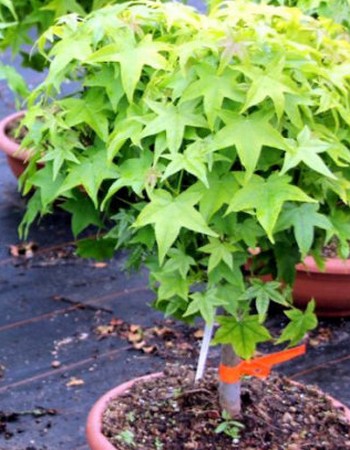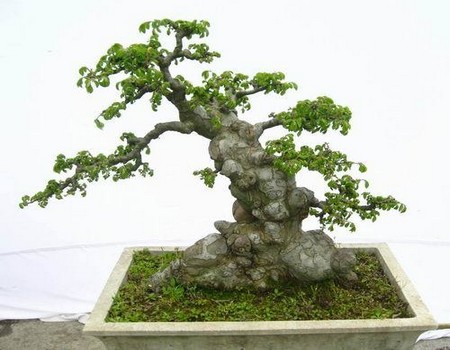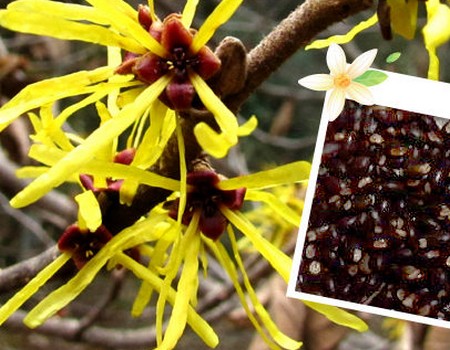Propagation methods of witch hazel
Golden plum blossom is peculiar in shape and fragrant, early spring leaves bloom, petals such as line, light and graceful, for the important early spring flowering seedlings. It is suitable for solitary planting in the corners of dry gardens, the banks of poolside streams and the edges of seedling bushes. it is also a good material for making bonsai. Witch hazel peculiar petals, graceful tree posture, attracting a lot of people, if coupled with stone flowers and plants, a tree, a scene, naturally. So how does witch hazel reproduce? Let's learn about it next.

Witch hazel is mostly born in hillsides, valleys and other places, it is an alpine tree species and a warm tree species, but witch hazel has strong cold tolerance and can grow in the open field at a temperature of minus 15 ℃. Witch hazel is mainly sown and propagated, and it can also be reproduced by striping and grafting.
1. Sowing and propagating Hamamelis (details) from December to March of the following year. The ripening period is October. The capsule is yellowish brown when mature and has the habit of dehiscing the seedling seeds. Therefore, the harvested fruit should be covered and dried to avoid the loss of seedling seeds. A thousand seeds of seedlings weigh 65 grams.
Seedling seeds have a long dormant period, so they do not germinate in the same year after sowing, but will germinate in the spring of the following year. Therefore, most of the seedling seeds use wet sand stratification for one year, and then sow in autumn or spring. Strip sowing is used with row spacing of 20-25 cm and sowing depth of 2 cm. Cover the soil after sowing, shade the sun after emergence, keep the soil moist, pay attention to waterlogging in the rainy season, and stop shading in mid-late September. The seedlings will continue to be cultivated in place for a year. After the end of the second year, they were retransplanted to cultivate big seedlings.
2. Striping reproduction can be carried out in both spring and autumn. Cut the branches under the node and bury them in the trenches that have been dug, with a depth of 6-8 cm. The top is facing up, the branches are fixed with bamboo sticks and then covered with soil, and the soil is often kept moist. It can be cut and planted with the mother plant in the next spring. Transplantation of witch hazel is more resistant to transplantation. It usually takes place from October to November. Too late transplantation will affect flowering in early spring. Small seedlings should be transplanted with soil, while large seedlings should be transplanted with soil balls.
The reproduction of witch hazel is mainly sowing and reproduction, with interline striping. In the 10th month, the seeds were collected, covered and exposed to the sun to prevent the seeds from escaping. After threshing and cleaning, the seeds were sown or hidden to be sowed in January of the following year. No later than February at the latest, if sowing in March late, it will sprout and unearthed every other year. It sprouted and unearthed in late April, set up a shed for shading, kept the soil moist in the seedling stage, stopped shading in mid-late September, left the bed for one year, planted in the third year, and then cultivated for 2-3 years. Pressing strips in autumn, cut the lower branches under the nodes, press them into the soil about 6-8 cm deep, and then fix them with bamboo sticks. With the top facing up, the soil is always moist and can be separated from the mother plant in the next spring. Transplanting was carried out from October to November, and late transplanting affected flowering in early spring, small and medium-sized seedlings with soil, and large seedlings with mud balls. Witch hazel likes semi-shade and should be planted in places with short sunshine.
The harvested seedlings are sun-dried before sowing, and then sowed or stored in sand until the early spring of the following year. In the seedling stage, a shed should be set up to shade the sun to keep the soil moist. The striping can be carried out in spring and autumn, and the lower branches are cut and buried on the ground under the node to keep the soil moist and separate from the mother plant in the second year after rooting. The transplant should be carried out from October to November. Small and medium-sized seedlings should carry soil, and large seedlings should carry mud balls.
Time: 2019-06-11 Click:
- Prev

Shaping and pruning technique of bonsai of Robinia pseudoacacia
The branching rate of Robinia pseudoacacia is low, there are no lateral branches in the middle and lower part of the trunk, and the trunk thickens slowly, and most of these trees are hard but slow in the process of Lignification, which makes the trunk of the seedlings thin and soft. Because the upper part of the seedling has high water content and dense leaves, it is easy to sprout and branch in the second growth, resulting in top-heavy and light, and the seedlings naturally bend after wind, rain and sun.
- Next

Sowing and propagation techniques of witch hazel
The shape of the flower is strange and fragrant, the first leaves of the grass open in spring, and the yellow slender petals are like golden wisps, covered with branches, which are very lovable. Gardens at home and abroad are often cultivated, and some good varieties appear, which is one of the famous ornamental flowers and trees. It is suitable in the corner of the courtyard, by the pool, by the stream, among the rocks and on the outer edge of the trees. In addition
Related
- Fuxing push coffee new agricultural production and marketing class: lack of small-scale processing plants
- Jujube rice field leisure farm deep ploughing Yilan for five years to create a space for organic food and play
- Nongyu Farm-A trial of organic papaya for brave women with advanced technology
- Four points for attention in the prevention and control of diseases and insect pests of edible fungi
- How to add nutrient solution to Edible Fungi
- Is there any good way to control edible fungus mites?
- Open Inoculation Technology of Edible Fungi
- Is there any clever way to use fertilizer for edible fungus in winter?
- What agents are used to kill the pathogens of edible fungi in the mushroom shed?
- Rapid drying of Edible Fungi

